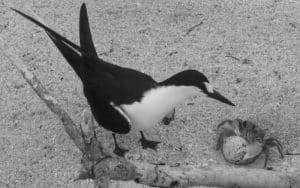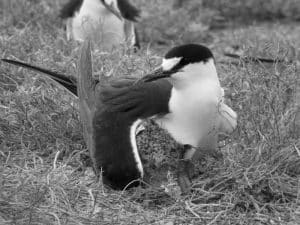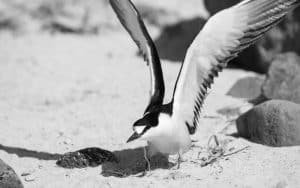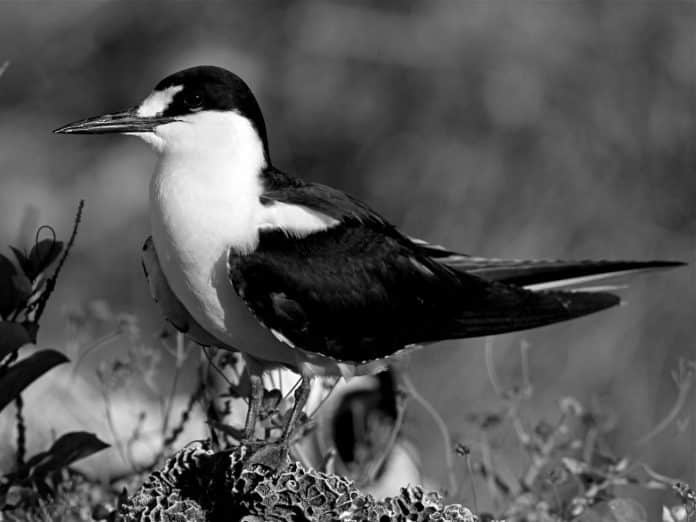Introduction to the Sooty Tern in Tanzania
Tanzania is a bird enthusiast’s paradise, and one bird that should not be missed is the Sooty Tern. The Sooty Tern in Tanzania, scientifically known as Onychoprion fuscatus, is a seabird that can be found in various parts of the world. This elegant bird is known for its striking appearance and remarkable behavior, making it a sight to behold for nature lovers. In this article, we will delve into the enchanting world of the Sooty Tern in Tanzania, exploring its habitat, distribution, physical characteristics, behavior, migration patterns, and the best time and locations to spot this magnificent bird.
Habitat and Distribution of the Sooty Tern

The Sooty Tern is primarily a seabird, preferring to nest and roost on remote islands and atolls. In Tanzania, these birds can be found along the coastline, particularly on the islands of Zanzibar and Pemba. These islands provide the perfect habitat for the Sooty Tern, with their sandy beaches, warm climate, and abundance of fish. The Sooty Terns in Tanzania are known to form large breeding colonies, with thousands of individuals nesting together on the same island.
Apart from Tanzania, the Sooty Tern can also be found in other tropical and subtropical regions around the world, including the Caribbean, the Indian Ocean, and the Pacific Islands. These birds are highly migratory and travel vast distances in search of food and suitable breeding sites. The Sooty Tern’s ability to thrive in various habitats and adapt to different climates has contributed to its wide distribution across the globe.
Physical Characteristics and Behavior of the Sooty Tern
The Sooty Tern is a medium-sized seabird with a streamlined body and long, pointed wings. It has a blackish-gray plumage, which gives it its distinctive sooty appearance. This dark coloration helps the bird blend in with its surroundings, making it less visible to predators when flying over the open ocean. The Sooty Tern also has a forked tail and a sharp, pointed bill, which it uses to catch fish and other small marine creatures.
In terms of behavior, the Sooty Tern is known for its impressive aerial skills. These birds are excellent fliers and spend most of their lives in flight, rarely venturing far from the open ocean. They are also highly social and form large colonies during the breeding season. The Sooty Terns engage in synchronized courtship displays, with pairs performing intricate aerial acrobatics to attract a mate. Once a pair is formed, they will build a nest together and take turns incubating the eggs and feeding the chicks.
Migration Patterns of the Sooty Tern
The Sooty Tern is a long-distance migratory bird, undertaking incredible journeys across the world’s oceans. In Tanzania, these birds can be seen during the non-breeding season, as they migrate from their breeding grounds in the Southern Hemisphere. They follow a circular migration pattern, traveling from the breeding colonies in Tanzania to the Northern Hemisphere and back again.
During their migrations, the Sooty Terns cover thousands of kilometers, relying on their impressive flying skills and their ability to navigate using celestial cues and the Earth’s magnetic field. These birds are known to travel in large flocks, often flying in a V-formation to reduce wind resistance and conserve energy. It is truly a remarkable sight to witness thousands of Sooty Terns soaring through the sky, moving in unison as they make their way across the vast ocean.
Best Time to Spot the Sooty Tern in Tanzania

If you’re planning a trip to Tanzania to see the Sooty Tern, it’s important to know the best time to visit. The Sooty Terns can be found in Tanzania during their non-breeding season, which typically falls between the months of November and April. During this time, the birds migrate from their breeding colonies in the Southern Hemisphere to their feeding grounds in the Northern Hemisphere.
To increase your chances of spotting the Sooty Tern, it is recommended to visit the coastal areas of Zanzibar and Pemba, where these birds are known to gather in large numbers. It’s also worth noting that the Sooty Terns are most active in the early morning and late afternoon, so plan your bird-watching adventures accordingly. Keep in mind that weather conditions can affect bird sightings, so be prepared for changes in wind, rain, or temperature during your visit.
Top Locations for Bird Watching in Tanzania
Tanzania is home to a diverse range of bird species, making it a popular destination for bird enthusiasts. In addition to the Sooty Tern, there are several other birding hotspots in Tanzania that are worth exploring. Here are some of the top locations for bird watching in the country:
- Serengeti National Park: Known for its incredible wildlife, Serengeti National Park is also a haven for bird lovers. The park is home to over 500 bird species, including raptors, waterbirds, and colorful songbirds.
- Ngorongoro Crater: This UNESCO World Heritage Site is not only a hotspot for wildlife, but also a great place to spot a variety of bird species. The crater is home to flamingos, ostriches, and many other waterbirds.
- Tarangire National Park: Located in northern Tanzania, Tarangire National Park is known for its large elephant herds and iconic baobab trees. It is also a great place to see birds such as the yellow-collared lovebird and the Kori bustard.
- Lake Manyara National Park: This scenic park is famous for its tree-climbing lions, but it is also a fantastic spot for bird watching. The park is home to over 400 bird species, including the pink-hued flamingos that flock to its alkaline lake.
These are just a few examples of the many incredible birding locations in Tanzania. Each region has its own unique bird species and habitats, offering endless opportunities for bird enthusiasts to explore and discover.
Tips for Bird Enthusiasts visiting Tanzania
If you’re planning a bird-watching trip to Tanzania, here are some tips to make the most of your experience:
- Bring a good pair of binoculars: A quality pair of binoculars will greatly enhance your bird-watching experience, allowing you to observe the birds’ intricate details and behavior from a distance.
- Hire a local guide: Hiring a knowledgeable local guide will not only increase your chances of spotting rare bird species, but also provide valuable insights into the local ecosystem and conservation efforts.
- Dress appropriately: Tanzania’s climate can vary greatly depending on the region and time of year. It is important to pack lightweight, breathable clothing and sturdy footwear for your bird-watching adventures.
- Respect the birds and their habitats: When bird watching, it is crucial to minimize disturbance to the birds and their habitats. Keep a respectful distance, avoid making loud noises, and follow any guidelines or regulations set by local authorities.
By following these tips, you can ensure a rewarding and responsible bird-watching experience in Tanzania.
Conservation Efforts for the Sooty Tern in Tanzania

As with many bird species, the Sooty Tern faces various conservation challenges in Tanzania. Habitat loss, pollution, and climate change are all threats to the long-term survival of these birds. However, there are several conservation efforts in place to protect the Sooty Tern and its habitat.
Local organizations and government agencies are working together to monitor breeding colonies, educate local communities about the importance of conservation, and implement measures to reduce human disturbance. In addition, initiatives such as beach clean-ups and the establishment of marine protected areas help to preserve the Sooty Tern’s nesting sites and ensure the availability of food sources.
By supporting these conservation efforts and practicing responsible tourism, visitors can contribute to the protection of the Sooty Tern and other bird species in Tanzania.
Other Bird Species to Look Out for in Tanzania
While the Sooty Tern is undoubtedly a highlight for bird enthusiasts in Tanzania, there are many other fascinating bird species to look out for. Tanzania is home to over 1,000 bird species, including a wide variety of raptors, waterbirds, songbirds, and migratory species.
Some notable bird species to keep an eye out for include the African fish eagle, the lilac-breasted roller, the grey-crowned crane, and the beautiful malachite kingfisher. Whether you’re exploring the national parks, the coastal areas, or the inland lakes and rivers, you’re bound to encounter a diverse array of bird species that will captivate and inspire you.
Conclusion: An Unforgettable Experience with the Sooty Tern in Tanzania
In conclusion, a visit to Tanzania offers bird enthusiasts an opportunity to immerse themselves in the enchanting world of the Sooty Tern. From its unique habitat and distribution to its striking physical characteristics and remarkable behavior, the Sooty Tern is truly a bird worth seeing. By exploring the best locations for bird watching, following key tips for a successful trip, and supporting conservation efforts, visitors can have an unforgettable experience with the Sooty Tern and other bird species in Tanzania. So pack your binoculars, prepare for an adventure, and get ready to be mesmerized by the beauty and wonder of the Sooty Tern in Tanzania.

































